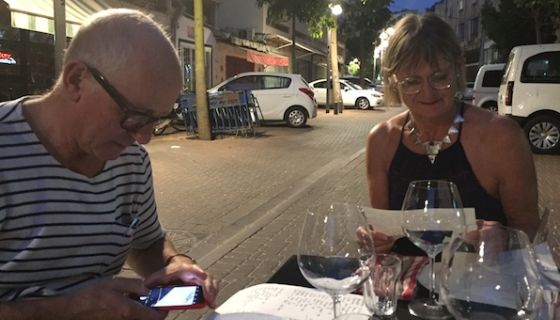One common factor links several of my favourite restaurants around the world, whether it be Osteria alle Testiere in Venice, Cibrèo in Florence, the new Union Square Café in New York and many around Tsukiji, the fish market in Tokyo. What links all these exciting places has as much to do with the compactness of their interior, a testament to the fact that food does not travel, as with the proximity of a food market. To this list must now be added Basta in the Carmel Market in Tel Aviv.
When we arrived at the remnants of the market just after 7 pm, the view was dispiriting. There were empty boxes everywhere; darkness had just fallen, making it awkward to discern precisely what we were treading on; and the nightly ritual of hosing down the streets had just got under way. As we walked into Hashomer Street, however, things improved dramatically. There were precisely laid-up tables and chairs that spilt out onto the street from Basta’s cramped restaurant premises and it was to one of these that we were shown.
Basta is now 10 years old but wears its age well. Founded by the enthusiastic, bearded giant Maoz Alonim, this restaurant takes its name from the numerous Turkish cafes called ‘basta’ that used to be common in this part of town. Alonim chose the name in response to an urgent request from his accountant that his new venture had a name before it served its first customer.
The location has proved highly successful. Its proximity to its suppliers means that Elon Amir, Basta’s young chef, works from a compact open kitchen in the midst of an area that houses many of his primary sources.
His fish merchant, run by a father and son, is no more than 50 metres away; the smart refrigerated units of his young butcher, whose shelves hold beef up to 40 days old, involves a walk of 200 metres; and, most intriguingly of all, down one alleyway is their Arab spice supplier who even showed us into his holy of holies, a back room where the spices are ground by stone rather than anything more modern, and in his view, more brutal. En route between them all there is always the chance to stop for a ripe mango, or a pitta bread stuffed with falafal at Elad’s long-running corner stall.
Basta’s immediate charms are broadcast by its menu, a single piece of rather scruffily written dishes that is often written twice a day. (You can see it on the table in the image above where I seem to be more interested in my phone.) Under four main headings, sea, greens & veg, meat and the ubiquitous small plates are a vast number of dishes that seem to comprise no more than two words. Yellowtail carpaccio was extremely fresh, okra ‘pocara’ was hot and spicy, while two crab dishes really showed off the kitchen’s dexterity.
First of all came a dish described simply as crab, green papaya. This was a bowl filled to overflowing with layers of a cooked and dismembered crab interlaced with this fragrant green fruit, the two ingredients bound by a fresh, spicy dressing. Then came a crab burek, the dark meat of the crab sitting in the centre of a rich pastry square, a combination made even richer by a thick butter sauce and crab eggs. Then came a pork schwarma, an unlikely mixture of pitta bread stuffed with grilled pork meat, a meat that makes an appearance here and on the menus of the two other Tel Aviv restauranst we dined at, Garrigue and Halutzim 3. We ended with a slice of a fine almond and raspberry torte.
To this highly appealing menu must be added the attractions of a first-class wine list and the expertise of Aviram Katz, Basta’s enthusiastic sommelier (bottom right of the main picture illustrating Wine returns to the Holy Land). Rarely, if ever, have I come across such a collection of red and white burgundies in the hands of someone so casually dressed (see Tel Aviv for burgundy – really). Katz’s uniform consisted on the night we ate here of a pair of blue shorts, a blue striped shirt (that almost hid a line of Catullus’s poetry tattooed just above his heart), and a red and white checked cloth which Katz draped over his shoulder.
This list has come about through a variety of reasons. Firstly, serious young wine drinkers in Israel began abandoning smart bordeaux for burgundy when prices of the former started to climb five years ago. Then, here as in so many countries where appreciation of food and cooking styles has changed so swiftly, the charms of the Burgundy grape Pinot Noir have been welcomed particularly in a country that is too hot to grow it. To both these elements has been added the passion of Daniel Lifschitz, a young Swedish-born goalkeeper with Maccabi FC, the city’s team, and his enthusiasm for this region of France. He is one of two specialist burgundy importers in Tel Aviv.
And while the list has gems from some outstanding white wine makers, including Ramonet and Roulot, these are somewhat over shadowed by the reds that include wines made by the likes of Leroy, Rousseau and Sylvain Cathiard at prices that will only rise as demand across the world continues to grow. We drank a 2014 Gevrey-Chambertin Le Clos from Duroché which, at 340 shekels, gave an enormous amount of pleasure and made a major contribution to the bill of 1,100 shekels (around £230 or $310) for four without service.
The wine may have been from northern Europe but the setting, under a full moon and with a warm wind blowing from the sea a few blocks away, could not have been more Mediterranean.
Basta 4 Hashomer Street, Tel Aviv, Israel; tel +972 3 516 9234













